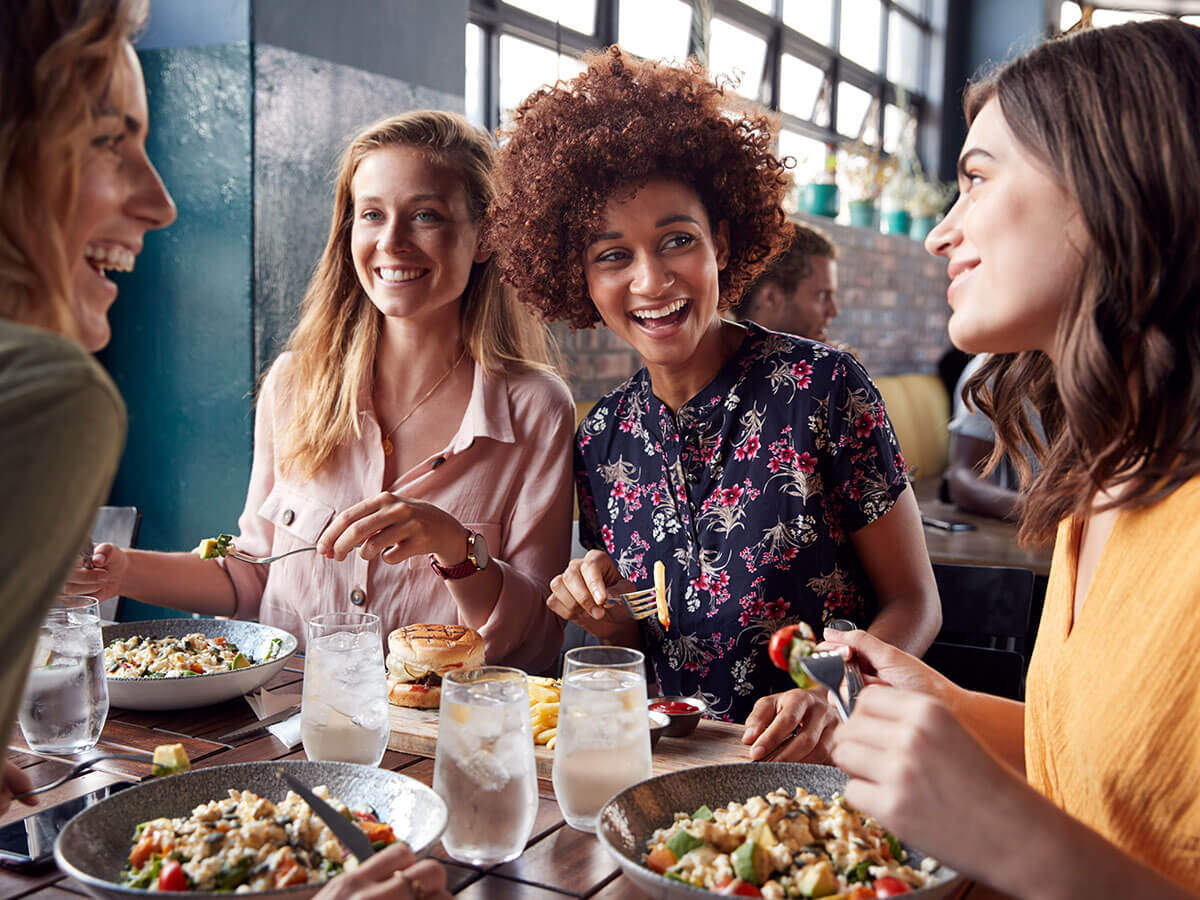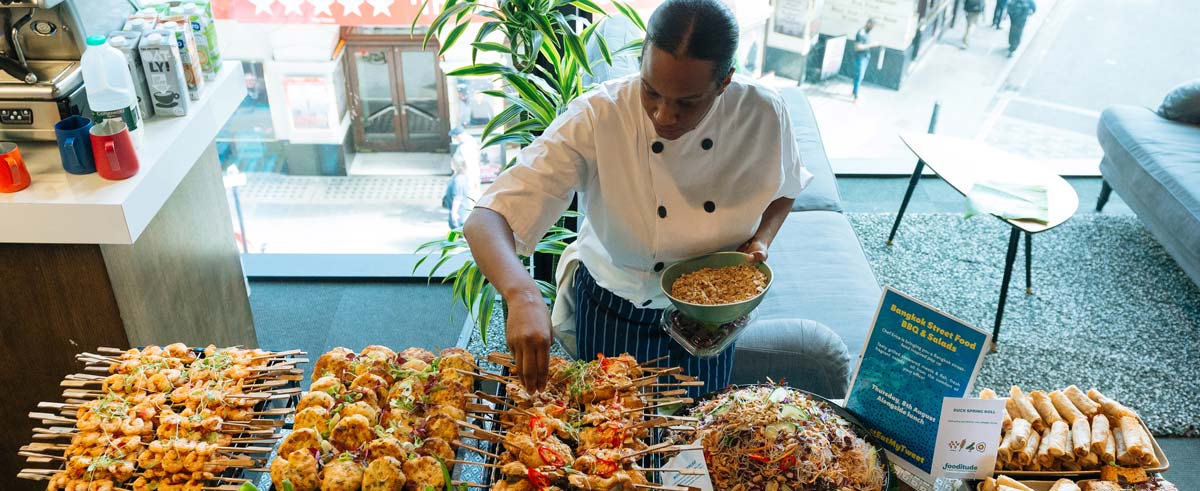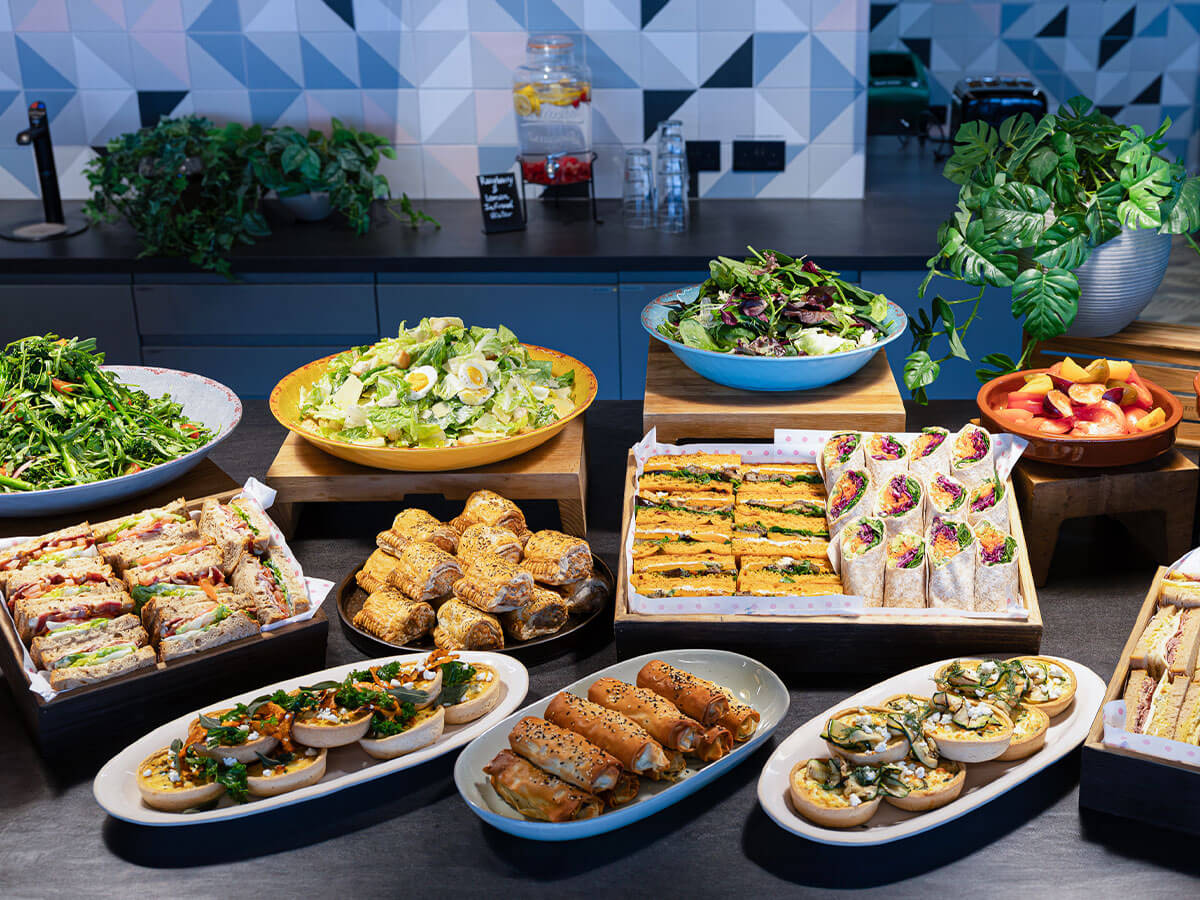"Food connects people." It’s a workplace truth that’s never been more relevant. As companies focus on creating vibrant, engaging office environments, they’re realising that great food is just as much of a perk as it is a powerful tool for culture-building, collaboration, and well-being.
Take Netflix’s UK team, for example. Their Workplace Manager describes their office lunches as "family-style experiences" that create team connection in a way no Slack channel ever could. And they’re not alone.
Providing catering to employees every day is also a great way to get people into the office and collaborate. According to a survey conducted by ezcater in 2024, “Eighty-eight percent of business leaders say that providing meals encourages more employees to work on-site. And 67% of hybrid employees agree, stating that free meals make the office more appealing.”
Taking this all into consideration, working with the right caterer can be a strategic decision that impacts everything from talent retention to company culture. But, with so many options out there, how do you separate the good from the great?
What Does Office Catering Look Like Today?
Office catering has come a long way from the days of in-house kitchens and uninspiring grab 'n' go options that encourage eating at desks. As the way we work has changed, so too has the way we eat at work.
Employees expect more than convenience - they want food that excites, nourishes, and reflects the diversity of their team. Employers are looking for catering solutions that support their hybrid workforce, sustainability, and seamless integration into their workplace culture.
When looking for the right catering partner, it comes down to working with a team of experts that is able to flex and adapt, ensuring your food programme remains a draw card rather than an afterthought.
The Evolution of Workplace Dining
A well-designed workplace catering programme needs to do more than just provide staff with meals, it should bring them together, support their well-being, and enhance their overall in-office experience.
Whether it’s daily meals, special events, or big meetings, think about how your office catering should fit into the natural flow and environment of your unique workplace.
Here’s how today’s workplace catering is adapting to the world of work:
Daily Workplace Dining
- Scalable food service offerings that flex with attendance.
- Snack stations for busy teams who need fuel in between meals.
- Fun, seasonality-driven menus that support employee engagement.
Special Events & Celebrations
- Team-building through interactive food experiences (DIY taco bars, anyone?)
- Catering for milestone events, client meetings, and big launches.
- Seasonal and cultural food experiences to make the office feel more inclusive.
Innovation in Catering Models
-
Flexible meal services that adapt to changing office attendance.
-
Pop-up food experiences to add excitement to office days.
-
Interactive food stations that encourage social connection.

The Forces Reshaping Office Catering
From sustainability to changing work patterns, several key areas are shaping how offices approach catering:
Sustainability is A Non-Negotiable
Employees expect more than just good food - they want food that’s ethically sourced, environmentally responsible, and waste-conscious. So, how are caterers driving sustainable efforts?
- They are partnering with local suppliers to minimise their carbon footprint.
- Food waste reduction initiatives are becoming a must-have, not a nice-to-have.
- Excess meals are delivered to local food redistribution programmes and community outreach initiatives.
Inclusivity & Dietary Needs Matter More Than Ever
A diverse workforce means a wide range of dietary needs and preferences, making inclusivity in catering incredibly important. Here’s what you need to think about:
- Allergen-conscious meal planning and multiple dietary options.
- Menus should reflect cultural diversity to ensure everyone feels included.
- Clear labelling and transparency around ingredients are essential.
Adaptability is Key
Workplace attendance is no longer a fixed number, and catering needs to keep up. Some days the office is buzzing, while on others, only a handful of employees are in. A rigid catering model just doesn’t work anymore. You need a catering partner that can:
- Provide scalable food services to fit in with fluctuating head counts – ramping meals or scaling them down based on who is in the office.
- Track employee attendance patterns to help minimise food waste.

Key Considerations When Evaluating Caterers
Finding the best workplace catering company means looking beyond the menu and budget alone. A great catering partner needs to align with your company’s culture, adapt to employee preferences, and bring consistency and creativity to workplace dining.
Look for a caterer who understands your team’s needs, values both flexibility and sustainability, and delivers consistently great service.
Here’s what to consider when making your decision.
Quality, Taste & Presentation
Workplace meals should be as good (or better) than what employees would choose themselves.
- Fresh, locally sourced ingredients make all the difference.
- A great caterer offers chef-led menus that balance nutrition with great tastes.
- If you are having food delivered on the daily – make sure your caterer has effective methods in place to ensure food is not spoiled.
- Presentation matters – people eat with their eyes first!
Service Excellence & Flexibility
Your office catering should be seamless, not stressful.
- Look for caterers with dedicated accounts and catering managers who understand your needs and will work closely with you to deliver exceptional meals and experiences, no matter the occasion.
- They should be flexible enough to handle last-minute changes without the fuss.
- Responsive service is key - no one wants to chase down a supplier for answers.
Menu Variety & Innovation
Offering a broad range of cuisines and seasonal dishes keeps meals fresh and prevents menu fatigue - make office dining more enjoyable.
- Work with a caterer that prioritises seasonal menu rotations - keeping things fun and new.
- Think about adding a mix of global flavours that helps everyone feel part of the team.
- Look for ways to include world festivity menus - adding excitement and engagement.
Budget & Financial Planning
Before engaging potential caterers, it’s important to establish a clear budget based on workplace needs, expected attendance, and company priorities. A well-fleshed-out budget ensures great quality catering while avoiding unnecessary spending and food waste.
- Outline a rough budget before reaching out to caterers. Factor in frequency, service level, and special requirements such as events or coffee stations.
- Office attendance fluctuates, so opt for caterers that offer flexible pricing models to scale up or down without waste or extra charges.
- Transparent pricing is key. Look for caterers that offer clear rates based on the type of programme you are looking for.
Reputation & Track Record
Look beyond a caterer’s menu offering - investigate their client history, reviews, and adaptability to changing workplace needs. A great caterer’s track record speaks for itself.
- Ask other workplace professionals in your network for recommendations.
- Ask for case studies and references from other companies.
- Meet with them to get a feel for how they work and to sample some of their dishes.

Your 5-Point Catering Evaluation Checklist
Choosing an aligned caterer is a big decision, with many factors coming into play such as offering, budget, collaboration and sustainability. The list goes on… A structured approach to evaluation helps cut through the overwhelming options and ensures you select a partner that can become an extension of your team while offering exceptional food services.
Here is a five-step process to help guide your decision-making, from assessing current catering setups to making the final choice.
Step 1: Assess Your Current Catering Setup
Before searching for a new caterer, it’s important to sit back and look at what’s working and what needs improvement within your current set-up. Assess everything from head count to food waste, in detail.
- Start by identifying gaps, which can include your current approach to sustainability, the model of catering service you use, the types of meals and menus you offer staff, hidden costs, food waste etc.
- Gather employee feedback. Do they enjoy the food currently offered? Are there complaints about variety, quality, or service? A survey or informal discussions can reveal valuable insights.
- Analyse your attendance patterns, especially in a hybrid work environment, to determine whether your current setup is efficient or if adjustments are needed. Identifying these factors will help refine your catering requirements and make sure your new food programme is aligned to your needs.
Step 2: Define Your Catering Priorities
Once you've assessed your current catering situation, it's time to establish clear priorities.
- What matters most to your company? Is it sustainability, dietary inclusivity, menu variety, or cost efficiency? Aligning food programs with company culture and wellness initiatives can have a huge impact on employee engagement and retention.
- Set realistic goals and ensure your budget supports them. This stage is also an opportunity to discuss logistics—does your team require daily meals, snacks, or catering for events? Understanding these priorities will make evaluating caterers much smoother.
- Put together a realistic budget and get buy-in from senior management and finance. This gives you a base to work from when engaging with potential vendors.
Step 3: Conduct Market Research
With your priorities in place, start exploring the market for caterers that align with your requirements. Industry referrals, online reviews, and case studies are a great starting point.
- Request sample menus to corroborate that the caterer offers a good range of high-quality options.
- Look into their operational reliability - do they have experience handling companies of similar size and needs? Do they operate from a centralised kitchen? Are they adaptable to fluctuating headcounts?
- Customer support is another crucial factor - reliable communication and flexibility make all the difference when you need to be flexible and make changes on-the-go.
- If they deliver to your offices every day, location is paramount. Working with a caterer on the other side of London for example isn’t a feasible solution. Find out how they deliver meals? Do they have in-house drivers or do they rely on third party providers for delivery?
Step 4: Shortlist & Test Potential Caterers
Once you’ve shortlisted potential caterers, it’s time to test them in action.
- Organise tasting sessions with a small team to get direct employee feedback on the quality and variety of food.
- Pay attention to presentation and freshness. How well does it hold up from kitchen to table? Visiting their kitchen can provide insight into their hygiene standards and preparation methods.
- Discuss service agreements, pricing, and flexibility. A strong caterer should be able to provide scalable options and work within your company’s budget while maintaining quality.
Step 5: Make the Final Decision & Implement
After testing and comparing your top candidates, it’s time to make a final decision.
- Use a structured scoring system to weigh factors like quality, pricing, sustainability practices, and customer service.
- Choose a provider that not only meets your practical requirements but also aligns with your company’s culture and values.
- Once selected, set up a clear agreement outlining expectations, service terms, and review cycles.
- Establish a feedback loop with employees to continuously improve catering offerings based on their preferences and satisfaction levels.

Making the Right Office Catering Choice
When all is said and done, a well-chosen caterer can really make a meaningful impact on day-to-day office life. Choosing the right provider means considering everything from food quality and flexibility to sustainability and inclusivity. By following a structured approach, you can make sure that your team gets a dining experience that’s not only enjoyable but also adds real value to their workday.
Want to create a dining experience that keeps your team engaged and satisfied?
Get in touch with Fooditude to explore how our tailored food programmes can bring your team together over meals they’ll love.




